Emojis are back! There’s been quite some fuss around Google’s decision to support emojis. They were disabled by Google in 2015, only to be revived one year later: Google said it would show emojis where relevant, useful and fun.
Since these types of characters are becoming so popular, we wanted to know if they had any impact on SEO & PPC and if we should use them or not.
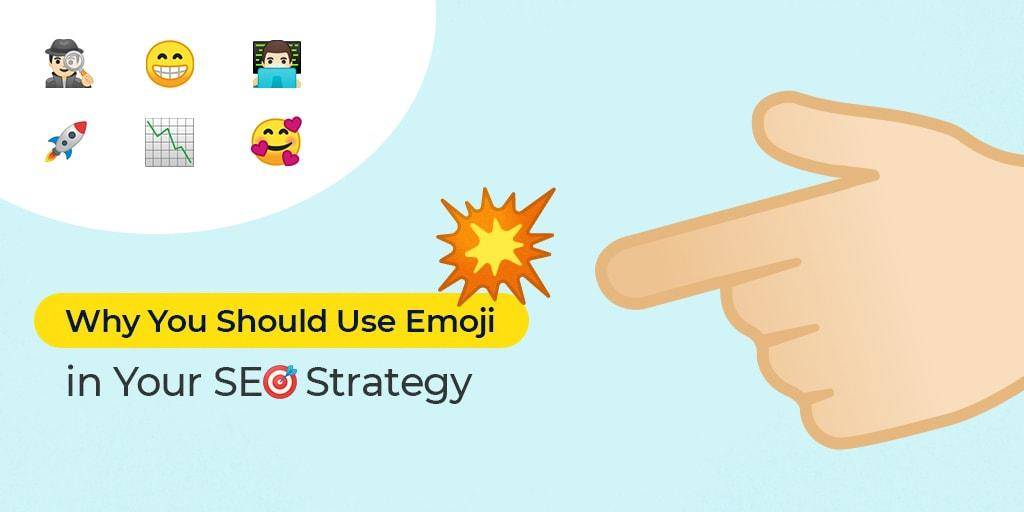
Today we’d like to find out why you should use emojis in SEO and PPC strategies, and how can it help your business.
Emojis are present in a piece of metadata, such as rich snippet or title tag and they can also be included in the title ads on AdWords. And since they can be added, lots of websites are already using them. It turns out that if you search for a specific emoji, such as “ delivery near me” or “
delivery near me” or “
 l trailer” (Deadpool trailer) – which was actually used in a billboard to promote the movie – or Google search for specific actors ( Kristen
l trailer” (Deadpool trailer) – which was actually used in a billboard to promote the movie – or Google search for specific actors ( Kristen  , Kevin 🥓 and so on) you can get accurate results just as if you’d searched using text.
, Kevin 🥓 and so on) you can get accurate results just as if you’d searched using text.
- Use Emojis to Increase Click-Through Rate
- Emoji Characters Can Improve Relevancy in Search
- Promote Local SEO Through Emojis
- Uphold User Experience by Using Emojis
- Take Advantage of Emojis to Increase the Trust Factor
Do Emojis Impact SEO?
Before starting to dive into all the reasons why emojis are useful, you should know how they can impact SEO and PPC.
We can say with no doubt that emojis are very used by lots of people. Millennials love them and prefer them instead of words. In a survey conducted by Harris Poll and commissioned by GIF platform Tenor, it resulted that 36% of millennials (ages 18 to 34) prefer gifs and emojis to have a better communication of their thoughts and feelings rather than using words.
For the same purpose, a study made by AdWeek reported that 92 percent of online consumers use emojis.
The illustrator Andrey Smirni, created an interesting infographic based on facts to support the emoji community and show the dimension of this function. Below you can see a cropped part:
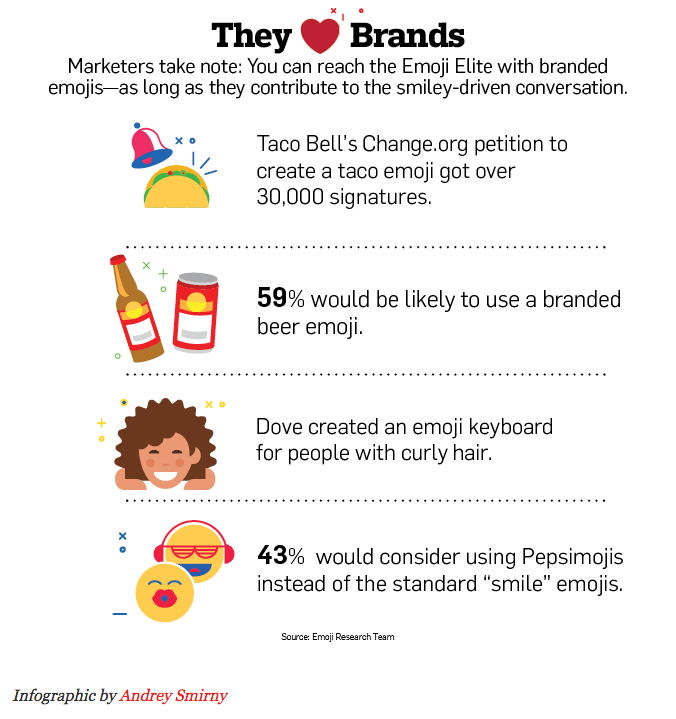
On the same topic, Dictionary.com create some original and very helpful content for those who want to learn and understand better how the emojis can be put to work in the most creative way.
- The first piece of article we laid eyes on was a list of quotes written using only emojis.

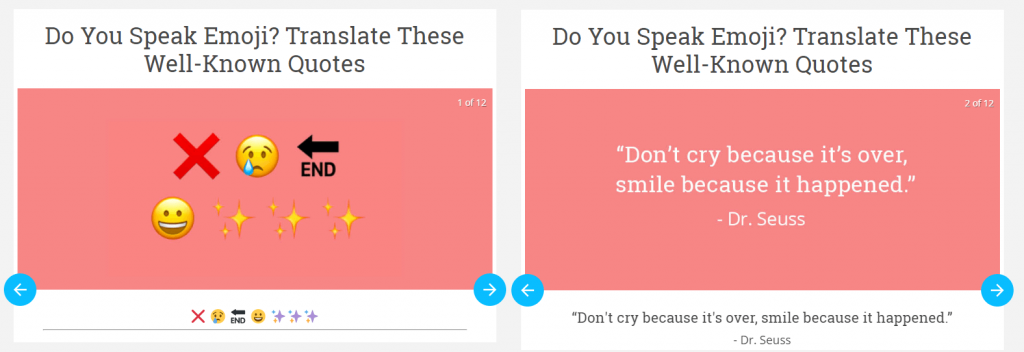
- The second one is an article that explains the direction of emojis, and how important is the ordering in a correct use of emojis in the online world.

Dictionary.com has always stayed on trend and offered great content and interesting topics to help people improve their vocabulary and boost their creativity.
1. Use Emojis to Increase Click-Through Rate
Yes, using emojis can help you increase the CTR for your website. If you are using emojis in your rich snippets, your page will stand up in the search and therefore will attract the user, hence an indubitable growth of the CTR. Check the example below:
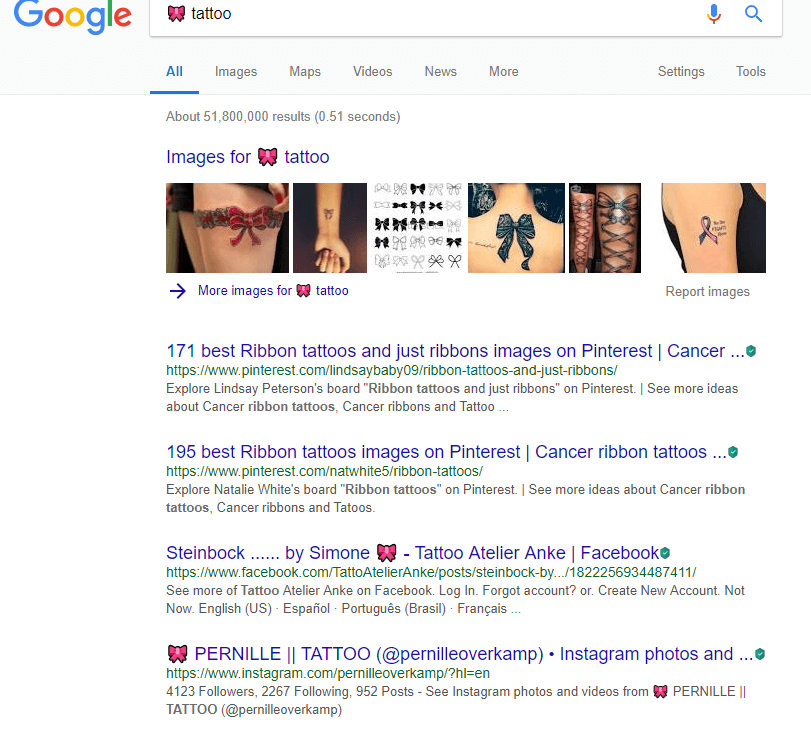
The attempt to show results with emojis shows that it is striving to understand user’s behavior and talk in their language.
Lots of Google’s representatives acknowledged that behavior data is used as a ranking signal. Edmond Lau, former Engineer at Google, explained how important click data is for every search engine.
| It’s pretty clear that any reasonable search engine would use click data on their own results to feedback into ranking to improve the quality of search results. Infrequently clicked results should drop toward the bottom because they’re less relevant, and frequently clicked results bubble toward the top. | |
| Edmond Lau | |
| former Engineer at Google | |
Lots of times Google showed that user behavior counts. Here’s a fancy way to put it – using their exact words:
| Searching users are often the best judges of relevance, so that if they select a particular search result, it is likely to be relevant, or at least more relevant than the presented alternatives. | |
| Google Patent | |
| Modifying search result ranking based on implicit user feedback | |
Expedia experienced this feature, by showing results using emojis to increase online visibility and boost the CTR.

We found great examples online for using emojis in the Google Adwords titles, too. Jennifer Slegg gave an example on her blog for a specific brand that produces yarn.
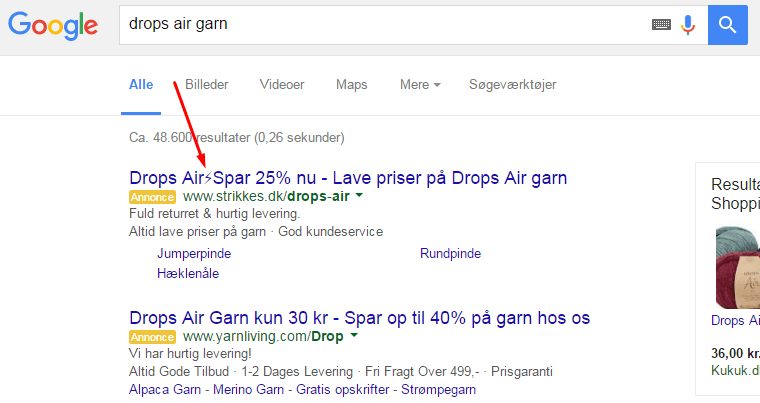
The master of PPC, Larry Kim, experienced the emoji featuring in AdWords to find out the impact it has on CTR. The results were astonishing.
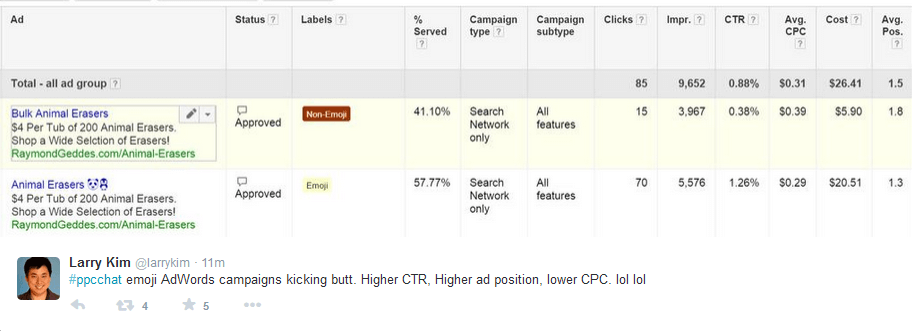
As you can see, the ad with the emojis had a 1.26% CTR and the one with no emoji had 0.38% CTR. If we look at the ads, they look exactly the same with the exception of emoji, so we can say with certainty that they were the key for getting better results. Using emojis in your AdWords titles can bring you an increase of 30% in click-through rate. Which will improve the Quality Score, which means better ad position and lower CPC, resulting in even higher CTR.
2. Emoji Characters Can Improve Relevancy in Search
Google’s main interest is to help the user get the most relevant results for the search query.
And it will be only natural and relevant to include emojis if the situation asks for them. For example, if we are talking about emojis or animals (we have animal emojis available) or something that is represented by an emoji, we could include one in our title or meta description.
There are two ways to trigger and use emojis in SERP. Either you search using an emoji (like you’d search using words) and you’d see mix results.
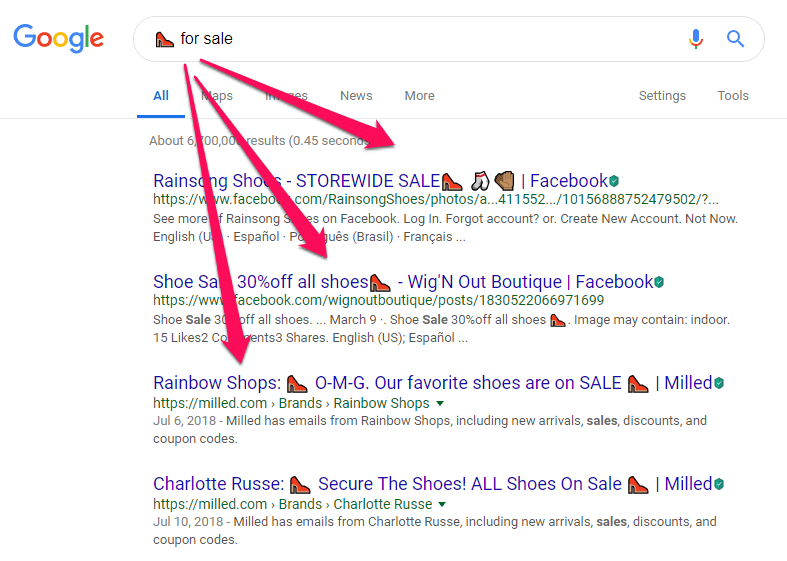
Or, the second option, search using words and see emojis in search results, amongst normal text.
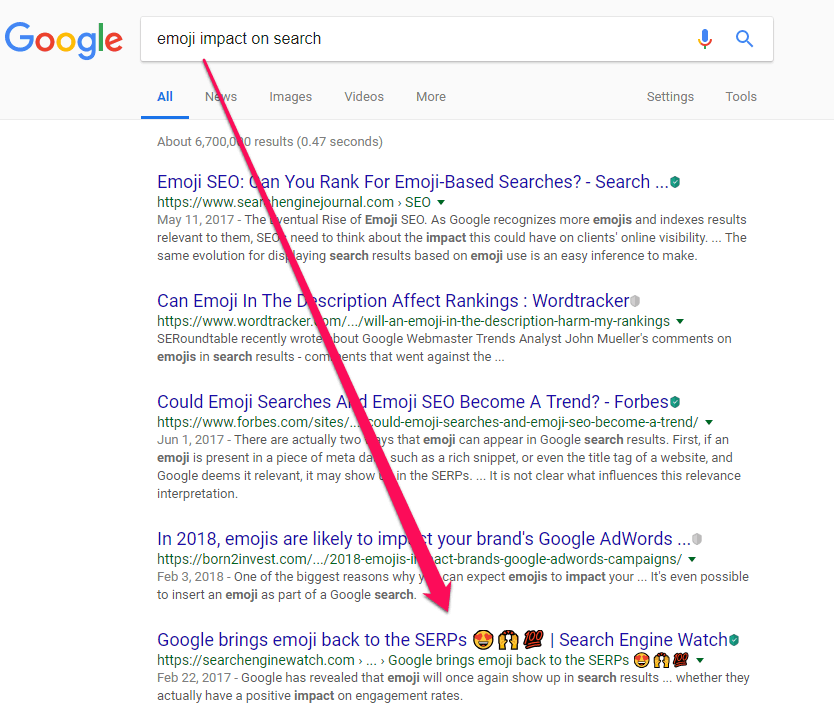
Google decided to support emojis, by showing them when it is only relevant, so it really depends on what the user searches for and how appropriate it would be to see results with emojis (in paid search and organic results).
3. Promote Local SEO Through Emojis
Emojis care work wonders for local SEO if we want to promote store and shops “near you”. SEO emojis are used in search if, for example when we search for food, for accommodation, for specific activities, for different activities, and other sorts of things.
Looking at the example below, we can see the results act like we were searching for the specific word – pizza.
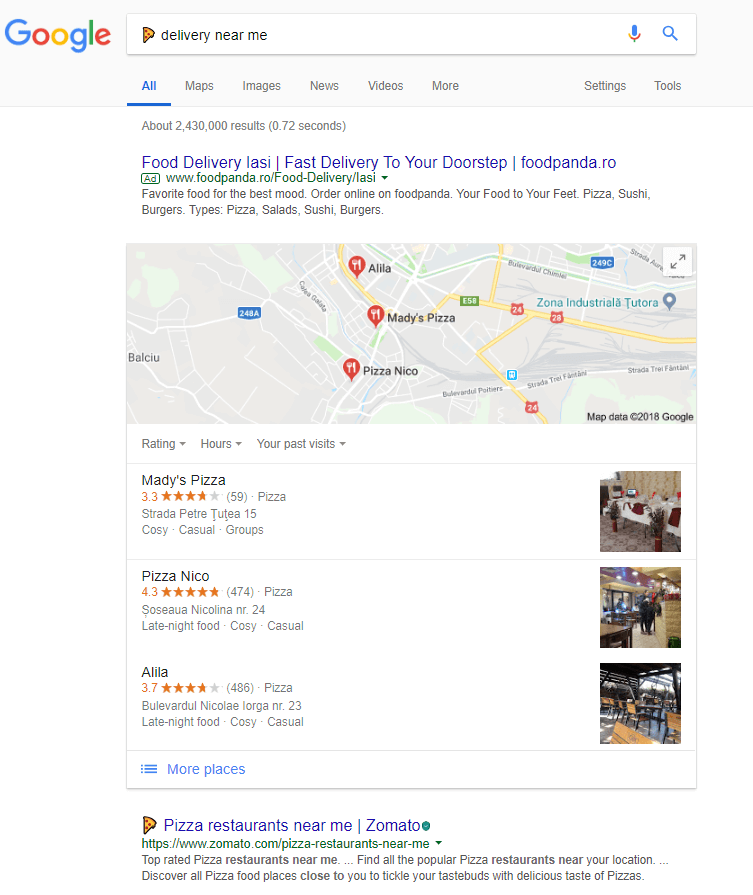
When we scrolled down the page, we could see a single result that was using the pizza emoji in the meta description:

Before seeing the results page, right after we’ve typed  , we received some other suggestions by Google, as you can see in the next screenshot.
, we received some other suggestions by Google, as you can see in the next screenshot.
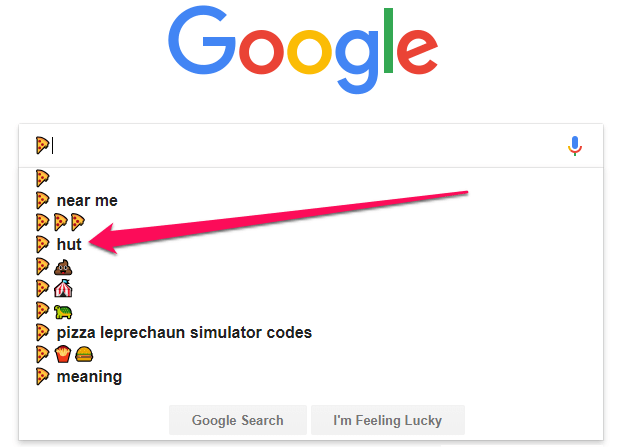
One of the results is a brand name – Pizza Hut, which can only mean that people are using emojis to search for brand names, too. That is a good indicator of emojis’ strength. Another great reason to use it in local SEO.
4. Uphold User Experience by Using Emojis
User experience is a well-known indicator of quality and Google has always put a lot of emphasis on it. On mobile, UX is a definitive ranking signal since it was the Google mobile friendly algorithm update which focused purely on user experience.
User experience has more to it than fast websites. It is also related to better navigation on the website, better human-computer interaction in the end. There are two things you should acknowledge:
- Using emojis can be an improvement in UX, by helping the users get faster results and searching faster through these small codes.
- It can improve user experience by offering results using the same language codes as the user (search using emojis, receiving results with emojis).
5. Increase the Trust Factor
Emoji characters can make your piece of content more relatable, enhancing the trust factor. Basically, these special characters create a deeper connection with the users since you are using the same language as them.
While some say this feature is more of a novelty rather than useful, I can only disagree. Even if they don’t represent much, used correctly, when the need arises might be of high value and increase the trust factor, which is very important. It can trigger memorability and future sales.
I wouldn’t depend solely on the emojis to boost rankings and get positive results but considering using emojis is a small investment where you can get a lot more out of it.
There were conducted lots of studies to see the connetion between emoji usage and trust. J. Jobu Babin, Assistant Professor of Economics at Western Illinois University, discovered that emojis do appear to be at least as important as simple text in one’s willingness to trust. Text also enhances trust, but emojis have a stronger effect.
Another study from Helen Wall, Linda Kaye from Edge Hill University and Stephanie Malone from Australian Catholic University, showed the impact of emoji usage and the level of trust for a dating site, such as Match.com. The results of the study showed a greater success at finding a match among people who use emojis regularly. Also, the users who were likely to want to get married, used emojis.
Conclusion
If you want to be on the hike, using emojis and any other feature Google enabled can only complement your digital marketing campaigns and improve your results. Before any dramatic changes make sure you follow the guidelines and best practices in the industry.
Emojis weight value in SERP and are a great addition to your content marketing strategy. Used correctly, when the need arises and provides relevancy, emojis can boost CTR and feed local SEO.
The post 5 Reasons Why You Should Use Emoji in Your SEO & PPC Strategy appeared first on SEO Blog | cognitiveSEO Blog on SEO Tactics & Strategies.
5 Reasons Why You Should Use Emoji in Your SEO & PPC Strategy posted first on http://nickpontemarketing.tumblr.com/
No comments:
Post a Comment